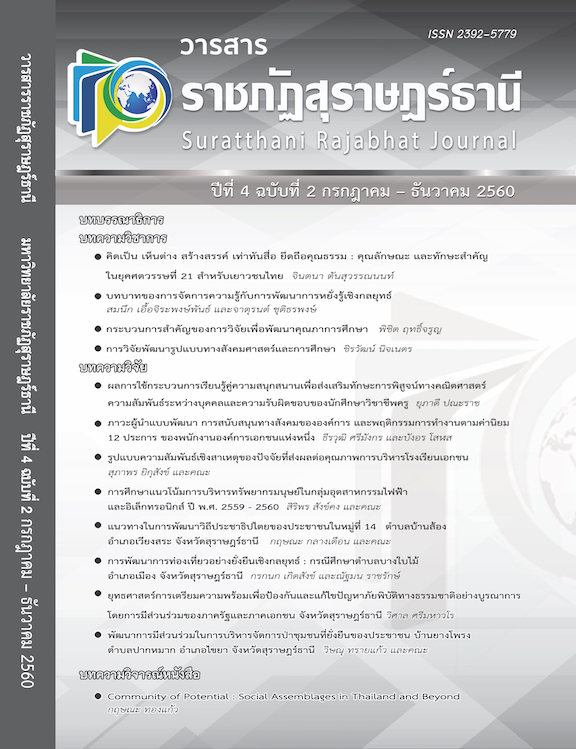Critical Thinking, Understanding and Collaboration, Creative Thinking, Media Literacy, and Conducting Ethical Rules: Key Traits and Skills for Thai Youth in the 21st Century
Main Article Content
Abstract
Advances in technological innovation and communication in the 21st century have inevitably led to dynamic and rapid changes: global citizens in the 21st century need to be ready to adjust themselves to effectively solve problems in their daily lives. It is a challenge to prepare human capital development so that it becomes stronger, and it is a challenge to create immunity to protect the citizens, especially the youth of the nation so that they can manage their risks, adjust themselves for a changing world in the 21st century, and move Thailand forward as per its vision: "stability, prosperity, and sustaining of the country.” The key attributes and skills for cultivating and developing Thai youth in the 21st century are composed of 1) critical thinking to be able to think and analyze or critique, 2) different views to be able to be open minded, see and understand the differences and respect each other, 3) creativity to be able to think creatively to develop innovation for a society, 4) media literacy to be able to analyze and use media effectively, and 5) uphold virtue by following a sufficient economic philosophy in every life. The developing key traits and skills are based on the cooperation of all relevant sectors, especially educational institutions which have a role to produce and develop Thai youth as quality and moral human capital in order to move Thailand forward in its vision.
Article Details
References
_______. (2559ข). ติดอาวุธทางปัญญา พัฒนาการรู้เท่าทันสื่อของเด็กและเยาวชน : สอนอย่างไรให้เด็กไทยรู้เท่าทันสื่อ. วารสารนิเทศศาสตร์ปริทัศน์ มหาวิทยาลัยรังสิต, 20,(1), 79 – 88.
จินตนา ตันสุวรรณนนท์ และคณะ. (2555). การพัฒนารูปแบบการเรียนการสอนเพื่อเสริมสร้างคุณธรรมจริยธรรมที่ยั่งยืนของนักศึกษาในระดับอุดมศึกษา.วารสารศึกษาศาสตร์ปริทัศน์, 27,(2), 137 – 148.
ทิศนา แขมมณี. (2558). ถอดรหัสปรัชญาเศรษฐกิจพอเพียงสู่การสอนกระบวนการคิด (พิมพ์ครั้งที่ 2). กรุงเทพฯ : จุฬาลงกรณ์มหาวิทยาลัย.
บรรจง อมรชีวิน. (2554). Thinking School สอนให้คิด. กรุงเทพฯ : ภาพพิมพ์.
พระธรรมปิฎก (ป.อ.ปยุตโต). (2545). พัฒนาการแบบองค์รวมของเด็กไทยฯ (พิมพ์ครั้งที่ 3). กรุงเทพฯ : สหธรรมิก.
ไพฑูรย์ สินลารัตน์ และคณะ. (2558). ศาสตร์การคิด : รวมบทความเรื่องการคิดและการสอนคิด. กรุงเทพฯ : DPU Cool print มหาวิทยาลัยธุรกิจบัณฑิตย์.
วรพจน์ วงศ์กิจรุ่งเรือง และอธิป จิตตฤกษ์. (2554). ทักษะแห่งอนาคตใหม่ : การศึกษา เพื่อศตวรรษที่ 21. กรุงเทพฯ : Open Worlds.
วิจารณ์ พานิช. (2555). วิถีสร้างการเรียนรู้เพื่อศิษย์ในศตวรรษที่ 21. กรุงเทพฯ : แผนพัฒนาจิตเพื่อสุขภาพ มูลนิธิสดศรี – สฤษดิ์วงศ์.
วิโรจน์ สารรัตนะ. (2556). กระบวนทัศน์ใหม่ทางการศึกษา: กรณีทัศนะต่อการศึกษาในศตวรรษที่ 21. กรุงเทพฯ : ทิพย์วิสุทธ์.
สุคนธ์ สินธพานนท์ และคณะ. (2551). พัฒนาทักษะการคิด...พิชิตการสอน (พิมพ์ครั้งที่ 3).กรุงเทพฯ : เลี่ยงเซียง.
สุทธิพร บุญส่ง. (2550). คุณธรรมจริยธรรมกับการพัฒนาคุณภาพชีวิต (พิมพ์ครั้งที่ 2). กรุงเทพฯ : ทริปเพิ้ลกรุ๊ป.
สุวิธิดา จรุงเกียรติกุล. (2558). ปรัชญา และมโนทัศน์สังคมแห่งการเรียนรู้. กรุงเทพฯ : ศูนย์ตำราและเอกสารทางวิชาการ คณะครุศาสตร์ จุฬาลงกรณ์มหาวิทยาลัย.
อภิษฎา ทองสะอาด และคณะ. (2558). พลังเสียง พลเมืองตื่นรู้ต่อการพัฒนาประเทศ. กรุงเทพฯ : แปลน พริ้นท์ติ้ง.
อัจฉราพร ศรีภูษณาพรรณ และณัฐวรรณ สุวรรณ. (2546). การพัฒนาทักษะการคิดเชิงวิพากษ์ของนักศึกษาพยาบาลในกระบวนวิชาการฝึกปฏิบัติการพยาบาลพื้นฐาน. เชียงใหม่ : คณะพยาบาลศาสตร์ มหาวิทยาลัยเชียงใหม่.
อารี พันธ์มณี. (2557). ฝึกให้คิดเป็น คิดให้สร้างสรรค์. กรุงเทพฯ : จุฬาลงกรณ์มหาวิทยาลัย.
Bergsma , L. J. (2004). Empowerment Education : The Link Between Media Literacy and Health Promotion. The American Behavioral Scientist, 48(2) : 152 -164. (Online) Retrieved from : http://www.coe.inf/t/e/ human-rights/media/forum strbgBergsmal Info doc04_en.pdf. [2006, January 29].
Boss, J. A. (2015). Think: Critical Thinking and Logic Skills for Everyday (3rd ed.). New York : McGraw-Hill.
Boyd, D. (2014). It’s Complicated: The Social Lives of Networked Teens. New Haven, CT : Yale University Press.
Cooper, J. L. (1995). Cooperative Learning and Critical Thinking. Teaching of Psychology, 22 (1), 7 - 8.
Ennis, R. H. (2002). Goals for a Critical Thinking Curriculum and its Assessment in Costa, A.I. (Ed.), Developing Minds (3rded.). Alexandria, VA : ASCD.
Hobbs, R. (2007). Reading the Media: Media Literacy in High School English. New York : Teachers College Press.
Jeong, S. H., Cho, H., & Hwang, Y. (2012). Media Literacy Interventions : A Meta-Analytic Review. Journal of Communication, 62, 545 - 472.
Kamat, V. (2012). New Trends in Education for the 21st Century (Online) Retrieved from : http://aview.in/allevents/new-trends-in-education-for-21-century. [2015, November 21].
Kellner, D. Media Literacy and Critical Pedagogy in a Multicultural Society (Online). Retrieved from : http://www.gseis.ucla.edu/faculty/kellner. [2005, August 15].
Livingstone, S., & Helsper, E. J. (2010). Balancing Opportunities and Risks in Teenagers’ Use of the Internet: The Role of Online Skills and Internet Self-Efficacy. New Media & Society, 12(2), 309 – 329.
Office of National Drug Control Policy. (2001). Helping Youth Navigate the Media Age : A New Approach to Drug Prevention. Findings of the National Youth Anti Drug Media Campaign Media Literacy Summit White House Conference Center. Retrieved from: http://www. mediacampaign.org/kidsteens/media_age.pdf. [2006, January 29].
Potter, W, J. (1998). Media literacy. Thousand Oaks, CA : Sage.
Silverblatt, A. (2001). Media literacy: Keys to Interpreting Media Messages (2nded.). Westport, CT: Praeger Publishers.
The Partnership for 21st Century skills. (2008). 21st Century Skills, Education, & Competitiveness: A Resource and Policy Guide (Online). Retrieved from http://www.21stcenturyskills.org./documents/21st_century_ skills_ education_and_ competitiveness_ guide.pdf. [2015, May 28].
Thoman, E. & Jolls, T. (2005). Media Literacy Education: Lessons from the Center for Media Literacy. In G. Schwarz & P.U. Brown (Eds.). Media Literacy : Transforming Curriculum and Teaching, (104), 180 - 205.
Unesco. (2012). Media and Information Literacy, Communication and Information. Retrieved from : www.unesco.org/new/en/ communication and information/media –development/ [2015, January 31].


